portable yarn count scale
F.B. Leferink, Oldenzaalschestraat 244, Enschede (Holland)
W.A. Le Blanc, 36 Elmway, Providence, R.I. (U.S.A.)

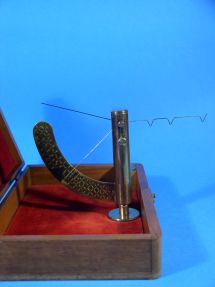
yarn scale, F.B. Leferink
| This yarn scale doesn't really fit into my collection of letter scales. But it's an intriguing scale, hence. Without a user's manual the operation is a mystery. With the help of Ritzo Holtman (GMVV) and the two parts article Yarn, Cloth and Roving Scales 1 and 2 by Michael Crawforth in Equilibrium, pages 1143-1150 and 1168-1176, plus a search on the web I discovered my yarn scale was not complete. The brass part I considered to be the adjusting weight was in reality only the cover of the adjusting weights compartment in which several adjusting weights should be. I made my own adjusting weight which moves the indicator from the lower mark up to the middle mark. Perhaps this gives an entirely wrong adjusting weight but for the clarification of the operation of the scale this doesn't matter. First I used a part of a sheet of 80 grams paper. I measured the sizes and calculated the weight in grams. According to Crawforth the test weights are aluminum. I don't have aluminum wire, therefore I use stainless steel wire of 0.4 millimeter diameter instead and make a small test wire and fold this into an U shape. The different instructions tell you to raise the yarn scale vertically in the
| 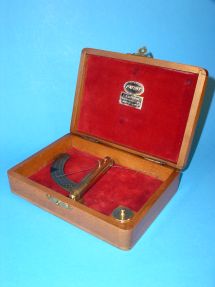
lying in the box
|
wooden box in such a way that the lower left indicator is on the (lower?) mark while the test weight is not yet in the right V-shaped notch of the weighing arm at the right. Put the test weight in the right V-shaped notch and check the position of the indicator, this should be at the middle mark (according to the German instructions). Now take away the test weight and put cotton threads into the V-shaped notch at the right of the right arm until the indicator exactly points the middle mark again. Measure the total length in centimeters of the single cotton thread, this results in the yarn counts. This value can be converted into deniers. Dividing 5315 by the counts results in the value in deniers.
This yarn count scale is suited for three types of textile fabrics: the right V is for cotton and also silk; the left inner V notch is for linen; and the middle V notch is for worsted. A German instructions sheet tells the right notch gives the English cotton number, the middle notch the metric number and the left notch the English linen number. For silk, nylon and rayon (artificial silk or viscose) one divides 9000 by the measured metric number to get the deniers value. A ticket attached to the yarn count scale shown at the website of MIAT (Museum of industrial archeology and textiles, in Ghent, Belgium) gives a different order of the notches and textiles, namely left rayone, middle cotton and right worsted and metrical. It can not all be true. I still have not found an explanation for the presence of three marks on this yarn scale. I used two marks to determine a test weight, see above, and that's maybe probably completely wrong. Who has good information for me?
F.B. Leferink from Enschede, Holland is not the only name attached to this yarn scale. Crawforth names W.A. Le Blanc from Enschede in Holland as seller and maybe maker. Holtman presented an information sheet on which below the name "W.A. Le Blanc Precision Instruments" the Portable Yarn Count Scale is presented. Also two addresses namely the address Oldenzaalschestraat 244 in Enschede (Holland) and also 36 Elmway, Providence 6, R.I. (=Rhode Island, U.S.A.). The sticker Patent suggests a patent was granted upon this yarn scale. I have not (yet) been able to find this patent.
The yarn count scale presented by Crawforth in the article has another extra notch at the end of the upper left wire. By attaching a test weight here one could increase the accuracy of the counts weighing to get an equilibrium one had to attach more length of thread at the right notches. Three weights were provided, resulting in multiplications of the counts by 5, 10 or 15. (See EQM pages 1148-1149).
The yarn scale made of brass exists of the following parts: a brass disk is rotatable mounted on the bottom of the wooden box. A brass rod is attached by a pivot on the brass disk. A brass tube is mounted over the brass rod. The tube can shift and rotate over this rod (telescopic rotating). A brass knob with screw fixes the tube on the rod when desired, provided the parts are slid sufficiently into each other. In and between the tube the weighing arm is pivoted by cones and pans. The pictures illustrate further details of this portable yarn count scale.
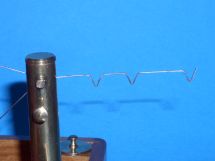
the weighing arm with the three
V-shaped mounting spots
|
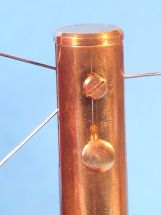
brass stand with
at top the pivot and
below the locking screw
|
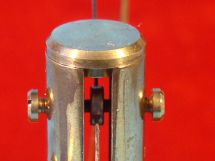
brass stand with the pivot
|
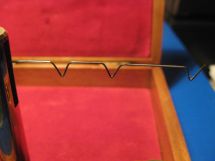
three V-shaped mounting spots
|
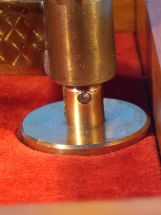
rotating disc brass stand
|
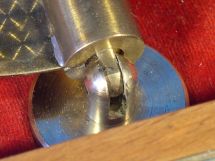
hinge brass stand
|
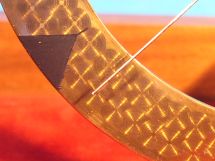
unloaded adjusted to the bottom mark
|
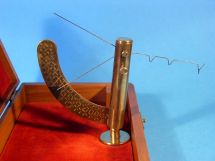
test weight hang in outer V notch
|
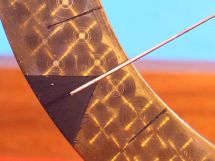
loaded with adjusting weight the scale
pointer reaches the middle mark |
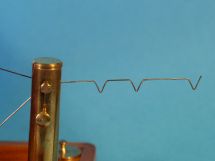
three V-shaped mounting spots
|
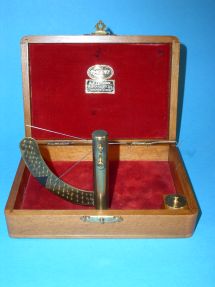
unloaded adjusted to the bottom mark
|
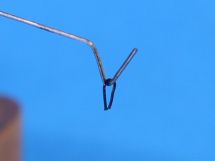
test weight hang in outer V notch
|
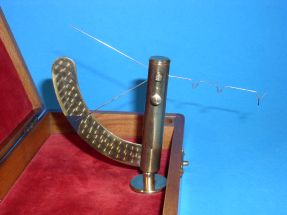
loaded with the test weight the indicator
reaches the middle mark |
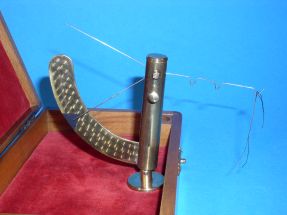
loaded with enough lengths of thread to bring
the indicator back to the middle mark |
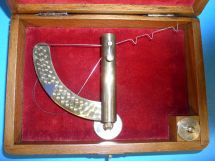
lying flat in the wooden box
|
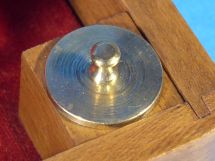
brass lid of the
weights compartment
|
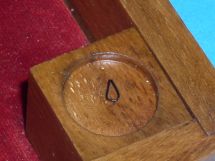
the adjusting or test weight in
the weights compartment |
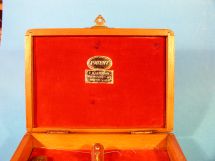
the lid with the stickers
|
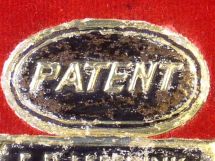
PATENT sticker
|
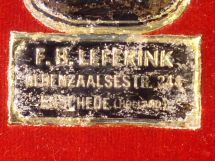
F.B. Leferink sticker
|
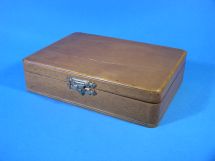
closed box
|
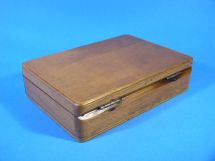
hinge side of box
|
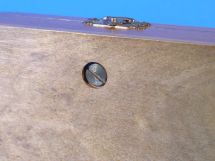
bottom with screw connected to the
brass rotating disc |

























